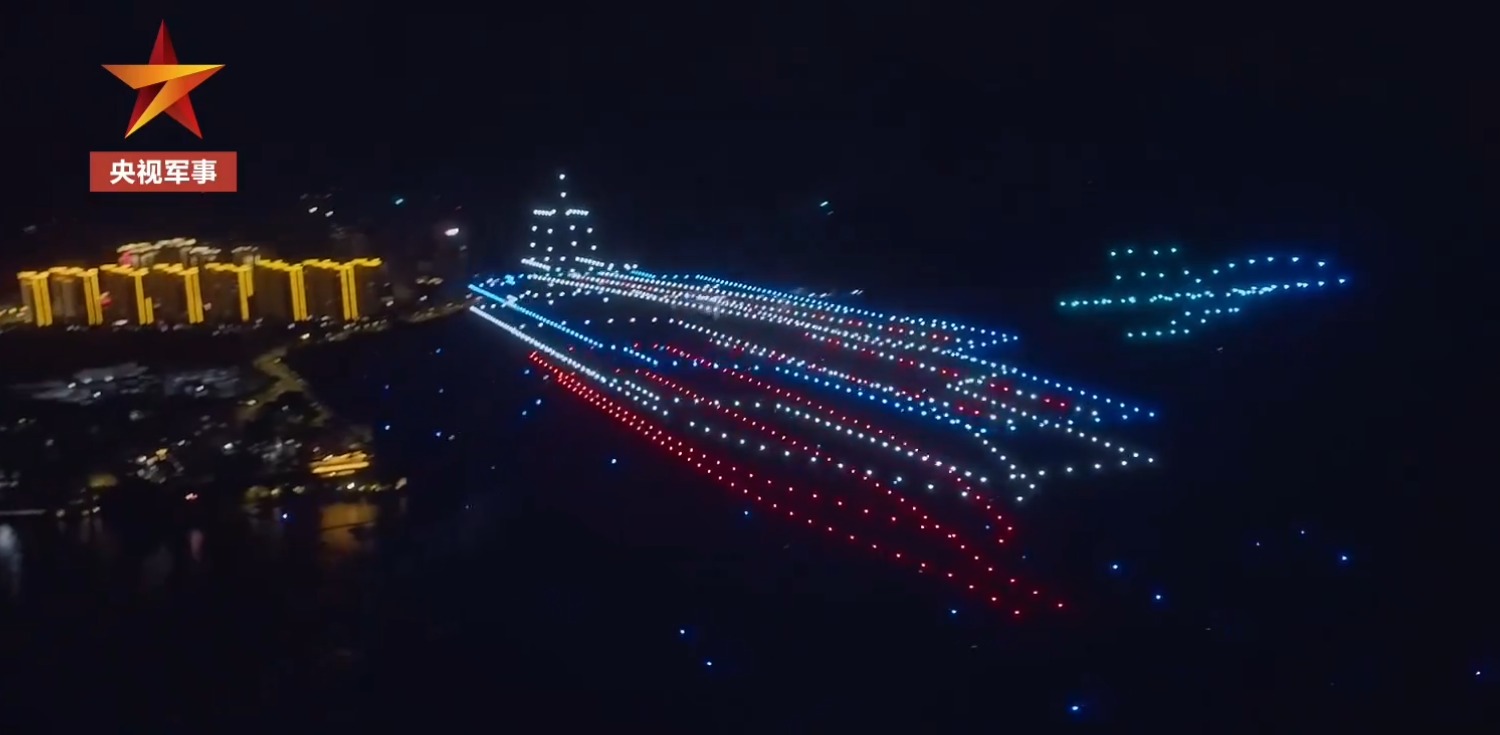A recently surfaced video attributed to the People’s Liberation Army (PLA) has appeared on social media. The video displays a spectacular light show created with thousands of unmanned aerial vehicles (UAVs) highlighting some of the PLA’s most advanced war machines.
The undated video was posted on X by Chinese journalists. EurAsian Times, however, could not independently verify the origin of the footage. According to claims and reports on X, the drone show was held in the Fujian province and aimed at attracting people to join the PLA.
The video shows the drones changing battle formations to mimic cutting-edge military equipment in China’s arsenal. The first is China’s third and latest aircraft carrier, Fujian. The drones also show the PLA Navy’s (PLAN’s) primary carrier-capable fighter, the J-15, taking off from Fujian.
Launched in June 2022, the Fujian is the first aircraft carrier in China to be outfitted with electromagnetic catapults. Chinese experts have noted that the Fujian can host more aircraft due to its greater displacement and electromagnetic catapults, which enhance the carrier’s launch capabilities. The Fujian is currently undergoing sea trials, which began in May 2024.
Forget J-20, China’s H-20 Stealth Bomber Threatens ‘Easy Penetration’ Of LAC; How Can IAF Respond?
Fujian will initially host J-15 fighter jets, a heavy carrier fighter jet. It will later be joined by the next-generation stealth fighter jet, the J-35. The carrier has been projected as the world’s most advanced conventionally-powered aircraft carrier and is expected to play a significant role in modern combat.
Marvelous!
In China🇨🇳, thousands of drones formed patterns of the J-20 stealth fighter, China’s 3rd aircraft carrier the Fujian, and many other weapons. pic.twitter.com/7Xbl58l7Ep
— Hu Xijin 胡锡进 (@HuXijin_GT) July 20, 2024
Next in the video, the Chinese drones realign to form the image of a J-20 Mighty Dragon in the sky, the fifth-generation stealthy workhorse of the PLA Air Force (PLAAF).
China is only the second country—after the United States—to actively deploy fifth-generation aircraft in the world. China has now stationed J-20 fighter jets in all PLA theatres and is expected to field at least 1,000 aircraft by the mid-2030s.
The Mighty Dragons entered service in 2017, and the PLAAF already has over 200 of these fighter jets in its fleet. The goal is to take the number to 400 by 2027 and 1,000 by 2035.
After showcasing PLA’s premier naval and air capability, the drones align to show what appears to be a Main Battle Tank (MBT) and a Multiple Launch Rocket System (MLRS).
Then, the frame changes, and the drones fall in formation to create the Chinese mainland along with the self-ruled island of Taiwan. China considers Taiwan a renegade province and has vowed to merge with the mainland, with force, if necessary.
Accompanied by a striking Mandarin soundtrack, the drones also form the silhouette of a Chinese soldier carrying a rifle alongside three individuals displaying the Chinese flag and the communist symbol of the hammer and sickle.
As mentioned by a dedicated military watch account called Clash Report, the video also calls for recruitment, with the caption: “Join the army, serve the country!”
This may be significant given that China has been making concerted efforts to enlist more PLA personnel in recent times and, if reports are anything to go by, is struggling with it. Though it cannot be said with certainty, netizens said the promotional video appears to be an attempt to attract recruits for the PLA.

China’s PLA Recruitment Woes
Under President Xi Jinping’s direction, China has been stepping up its military recruitment drive to bolster and modernize its armed forces, with a notable increase in the last 12 months.
In addition to its ex-officers, China is hiring highly trained foreign veterans and technically qualified students. State-owned Enterprises (SOE) and private businesses are concurrently building volunteer armies.
In 2022, amid heightened tensions in the Taiwan Strait, Beijing launched a recruitment drive for the People’s Liberation Army that granted preference to university students majoring in science, technology, engineering, and mathematics and removed age restrictions.
Last year, the PLA Navy sought graduates from Tsinghua University—a public university in Haidian, Beijing—and other top civilian institutions to serve as fighter pilots for its aircraft carriers. The Navy mandated that the applicants be under 24 years old, single, and major in science, technology, or engineering.
In addition to having “good vision and suitable nutritional condition”, they should “love the air and sea”. At first, the PLAN allowed women to apply for these positions, signaling a glaring shortage.
Late last year, reports indicated that China posted recruitment messages on WeChat, seeking young and middle-aged recruits for duty officers and administrative roles. These messages aimed to attract civilians by offering them superior benefits than those received by civil servants in the country.
According to a study conducted by Loro Horta for Singapore’s S. Rajaratnam School of International Studies, one reason why China finds it difficult to draw recruits is that parents are hesitant to enlist their only child in the military because of China’s long-standing, though now-abandoned, one-child policy. Another reason listed by the study is the salary. Horta noted that in China, the incentives to work for the state were not nearly as appealing as the rewards provided by the private sector.
To fill staffing shortages, the Chinese Navy has also broadened its pilot recruitment campaign to include postgraduate students. A recruitment plan released in 2023, for instance, stated that for the first time, applicants who wanted to pursue a postgraduate degree in 2024 were eligible to join the People’s Liberation Army’s Navy.
It has been a matter of severe concern in China that while the country fields some of the most cutting-edge military equipment in the world, it does not have enough skilled operators. This has been referred to as a class case of “equipment awaits talent” in the PLA.
- Contact the author at sakshi.tiwari9555 (at) gmail.com
- Follow EurAsian Times on Google News




